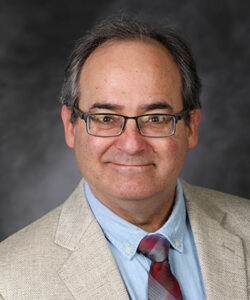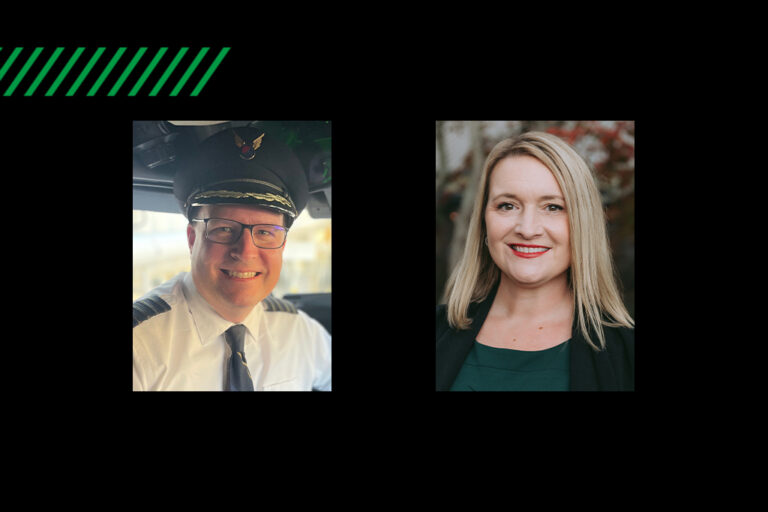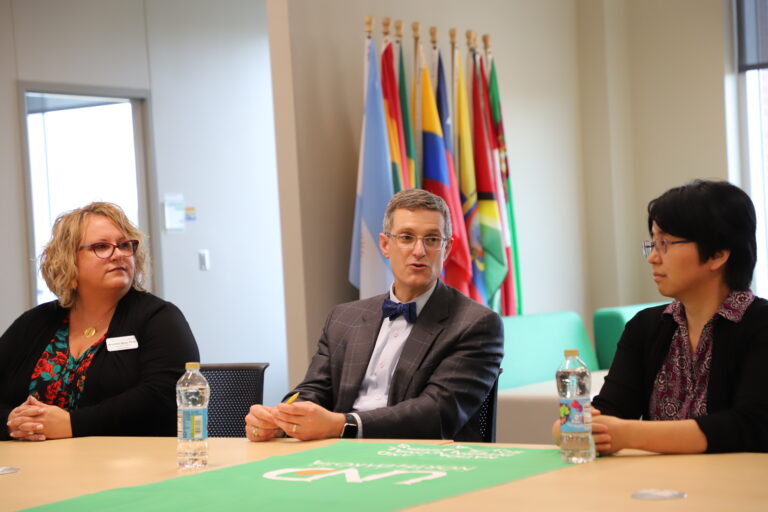The Center at the center
UND alumni at the Heart of America Medical Center pull together through the 2020 pandemic
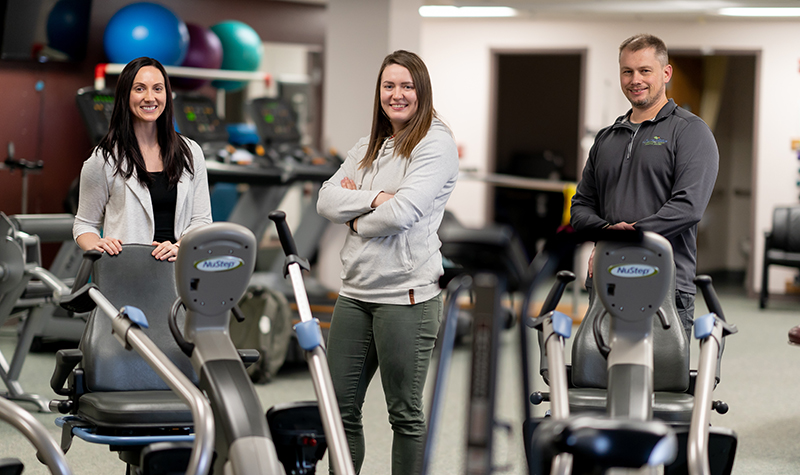
Its title is fitting: Heart of America Medical Center. While the town is known for being the geographical center of North America, Rugby’s medical facility is at the center of health and wellness of the town – now more than ever.
Dustin Hager, a certified physician assistant, ’10, pulls out vintage photographs to show how the campus has expanded from the original hospital into a multi-service healthcare facility. His phone buzzes.
“I’m going to catch this message, real quick. It’s a thank-you message from the wife of [a patient].” Dustin texts a reply.
Texts, calls or stops at the grocery store from community members with medical questions are regular occurrences for Dustin who grew up in the area and is a leader in the community. He’s one of seven medical providers at Heart of America who graduated from UND. Being a rotation site for UND School of Medicine & Health Sciences (SMHS) students has been a natural recruitment tool.
When COVID broke, many looked to Dustin, Chief Medical Officer and Operations Officer, and Heart of America’s executive leadership team to prepare for the worst.
“We put some good plans in place and completely new processes that didn’t exist before. We developed a respiratory clinic; we figured out ways to separate hospital patients from emergency room patients so they weren’t intermingling,” said Dustin. “It really took a team – medical providers, nursing staff, business staff – to sit down and figure out how can we collectively make this work. And then, we kept rolling.”
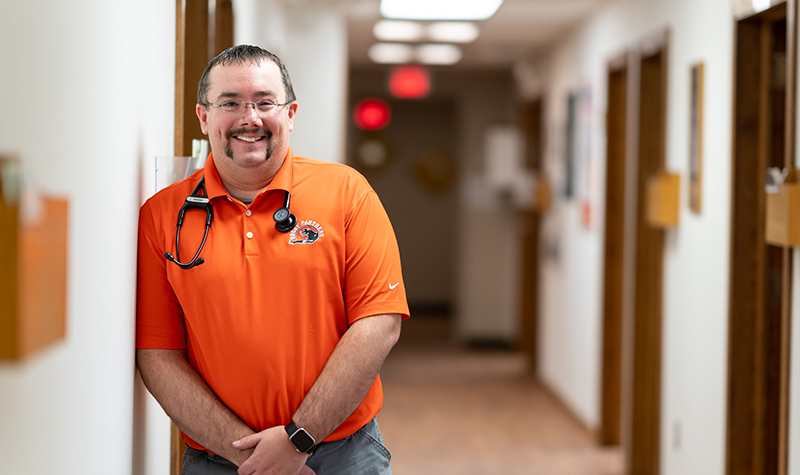
Pierce County was nearly untouched by the virus until October. Positive cases spiked in November, hospitalizing [number] of patients. Dustin recalled his lowest point: when COVID-19 got into the long-term care unit. Out of 47 residents, only 10 remained COVID-free and 14 passed away. The mental exhaustion has been draining for staff, especially because of the close connections common in rural communities.
Like every good leader, Dustin has found ways to support his team from catered cookouts to voluntary chaplain-led prayers in the morning and debrief sessions.
“I have an open-door policy, and I’ve had multiple staff members sit in my office and express their fears, their frustrations, their concerns and shed some tears. And we talk through it, we work through it. That’s what we do.”

Checking in
John Brandt, ’98, and Kayla Sendelbach, ’20, are two physical therapists (PTs) who work in the COVID unit alongside Dustin and other clinicians.
When treating patients donning full COVID-19 personal protective equipment, simple tasks such as helping them get out of bed become an extra challenge. But that’s always the goal.
“If we don’t keep them functioning, keep them moving, they might never make it home. And some didn’t,” said John. “But then you saw others who made it through.” Like a woman in her 80s who needed 10 liters of oxygen per minute to function. After a successful medication and therapy regimen, she was discharged back home COVID-free. “Knowing that you were part of that process and part of the team that helped, that feels good,” said John.
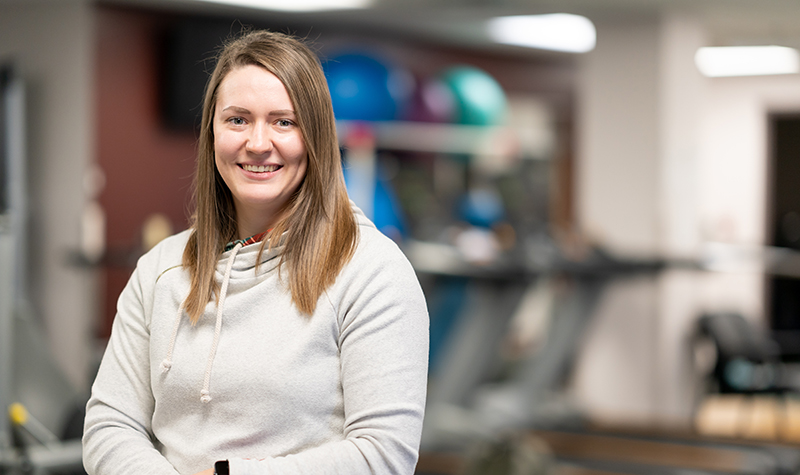
Across departments, Heart of America employees talk about the important role of teamwork in seeing positive outcomes throughout the trials of 2020. Whether more detailed patient charting, increasing safety procedures, or simply taking time to check in on one another, every little action went a long way in collective success.
Kayla rooms with former SMHS classmate and current PT colleague at Heart of America, Katie Holzheimer, ’20. They have a built-in support system with each other and with former SMHS classmates, hopping on Zoom calls to swap ideas and share struggles.
“It’s nice to know that everyone’s in the same boat – whether you’re treating COVID patients or not – you’re still having to go through all these precautions. Just making sure that your coworkers are OK, I think is what has been the biggest thing throughout all this,” Kayla said.

Bringing work home
Upstairs in the new Human Resources wing, Lauren (Christenson) McClintock, ’19, is relieved to see staff nearing full capacity once again. She described the difficulty of managing personnel needs during a pandemic made easier by the willingness across departments to fill in the gaps: nursing staff took extra shifts and her own colleagues put a hold on board deadlines to pitch in.
“We would be coming in on weekends – I would do housekeeping or dietary – we just needed the help at the time,” she said.
As UND students, it was a dream of Lauren and her husband (who tied the knot in true pandemic fashion outside of the Gorecki Alumni Center last summer) to someday come back to their hometown. Now, working in the same organization where Lauren’s father is the CEO and mother is the director of the business office adds new meaning to “bringing work home.” It has also given her front-row seats to watching her family rise to the occasion.
Lauren’s father, Erik Christenson, even stepped away from his desk to use his longtime pharmacy career to manage and distribute medications in the COVID unit, setting a precedent for others. “He loves this community and would do anything for it,” said Lauren.
The community showed love right back. Small businesses donated food, banks sent thank-you gifts and the clothing store made t-shirts for healthcare workers. Faithful volunteers have been eager to get back to work. “We had a ton of our volunteers here yesterday just waiting in line for about an hour or two to get the vaccine because they wanted to come back and just help,” said Lauren.
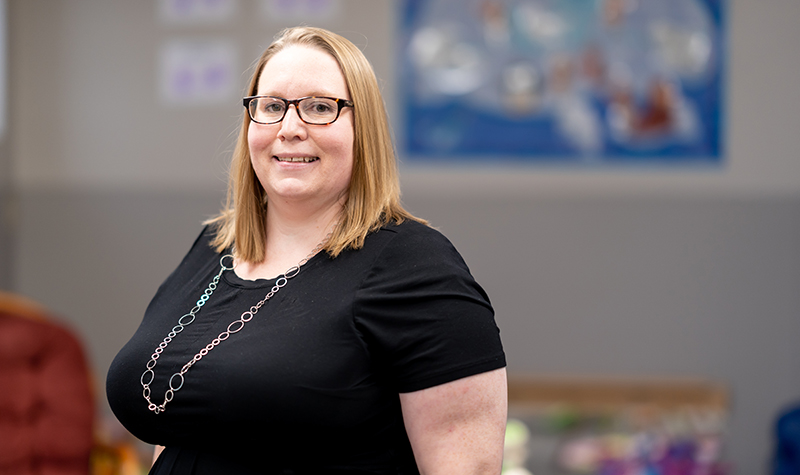
The kids next door
Across the medical campus, Amy Peterschick, ’11, has dedicated countless extra hours putting children’s safety first. Amy is the director of Kids Next Door, a childcare center owned by Heart of America. At a time when families are scrambling because of daycare or school closures, Kids Next Door has remained open to care for children of Heart of America staff. Only once has it closed for disinfecting purposes.
Amy’s 19 years of prior experience at UND’s University Children’s Center have helped her remain nimble while maintaining educational structure. This year, she has woven COVID-19 precautions into daily activities. “Some of [the kids] have had grandparents who have died, so they understand the gravity of this virus and have learned why we wear masks, wash hands more carefully and distance when possible.”
Buy-in from parents has helped. “I’m lucky that I have parents who are providers,” Amy said. She consulted with some to build a three-tier plan. Until recently they operated in Tier 2: children ages 3 and up wear a mask, temperatures are taken four times a day and regular health checks are conducted.
Unlike many daycare facilities, Kids Next Door has been able to take a financial hit because they operate as a service of Heart of America. “Our CEO understands that we’re not making money now, we’re not at our max limit because of COVID but we are safe,” explained Amy.
It has also allowed them to alter their services. For instance, when Rugby’s school went to distance learning, Amy took in the school-age children for full days and helped them complete their virtual lessons.
Dustin, who has had four children enrolled in Kids Next Door, applauded the extra work of departments like the daycare for keeping Heart of America running: “These are the types of things you can do in a small facility – tailoring to the staff’s needs so they can be more responsive for the organization’s needs.”
Getting the job done
Trials reveal what lies at the center. For this medical facility, located at the geographical center of North America and the heart of the town, it’s teamwork, it’s flexibility and it’s grit. As Dustin says:
“Ultimately, I would point to our team and the good staff that we have here at the hospital coming together, in spite of everything that we’ve been through. You know, pulling up the bootstraps and just getting the job done.”
